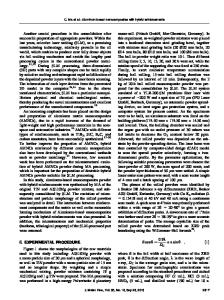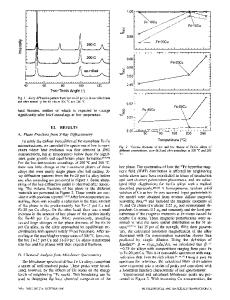Hall-Petch Relationship in Nano-RuAl Prepared by Mechanical Alloying
- PDF / 118,202 Bytes
- 6 Pages / 595 x 842 pts (A4) Page_size
- 92 Downloads / 319 Views
Hall-Petch Relationship in Nano-RuAl Prepared by Mechanical Alloying K.W.Liu* 1), F.Mücklich 1) and R.Birringer 2) Saarland University, 1) Department of Materials Science, Functional Materials, Geb.22; 2) Department of Physics, Geb.43, P.Box 151150, D-66041 Saarbrücken, Germany
Abstract A transition from a normal Hall-Petch relationship to an abnormal one is observed at a grain size of approximately 18.5 nm for nano-RuAl. Several models each representing a controlling factor have been employed to rationalize the transition mechanism. The grain sizes corresponding to the dislocation pile-ups lower bound [2] in grain interior are much smaller than the observed transition grain size and no apparent transition grain size has been derived from the grain size dependence of unit cell volume change [5]. While the grain sizes corresponding to the transition of strain rate according to Coble creep [1] and to the significant triple junction volume fraction [3, 4] (1 %) are well consistent with the observed transition grain size. The overall results indicate that the transition of H-P relationship is dominated by the weakening effect of grain boundaries and triple junctions.
Introduction Various mechanisms have been proposed to rationalize the transition of H-P relationship when the grain size is below a certain grain size. Chokshi et. al. explained the softening based on diffusional creep or grain boundary sliding [1]. Nieh and Wadsworth attribute the softening effect to the breakdown of dislocation pileups at a critical grain size [2]. Suryanarayana et al. [3] and Palumbo et al. [4] ascribe the transition the abnormal H-P relationship to the relative increase of triple junction volume fraction with decreasing grain size. The transition has been attributed to the lattice distortion effect by Lu et al. [5]. Recent computer simulation on the transition of H-P effect indicated that the strength below that predicted by H-P relation is due to the grain boundaries sliding [6]. In the present work, various models have been employed to elucidate the controlling factors for the obtained H-P relationship and the influence of internal structural evolutions on the transition of H-P relationship during grain growth have also been addressed.
Experimental Single-phase RuAl with a grain size of about 5 nm was prepared by mechanical alloying, for the details please see Ref. 7. The structure of as-milled and annealed powders was examined by X-ray diffraction (XRD) using Cu Kα radiation (λ= 0.1542 nm) at 45 kV and 40 mA in a PHILIPS X’Pert X-ray diffractometer and transmission electron microscopy (TEM) with an operating electron voltage of 200 kV (JEOL 200CX). LaB6 powders were used as standard sample to evaluate the instrumental broadening in XRD. Isothermal annealing was carried out by heating the powder at the fixed temperature for certain time under the flow protective gases. The microhardness measurements were performed on a Leitz microhardness tester using a Vickers indenter with a load of 50 g. For every measurement the load was applie
Data Loading...











